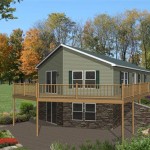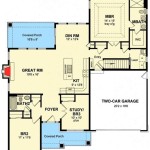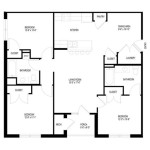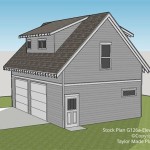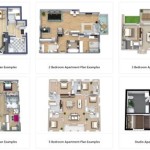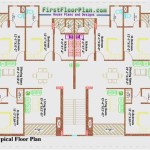Large Master Bedroom Floor Plans: Optimizing Space and Functionality
The master bedroom serves as a personal sanctuary within a home, a space for relaxation, rejuvenation, and rest. When designing a large master bedroom, the opportunities for creating a truly exceptional and functional space are vast. Careful consideration of the floor plan is paramount to maximizing space, achieving optimal flow, and ensuring the room meets individual needs and preferences. This article explores key considerations and common floor plan configurations for large master bedrooms.
Defining Zones and Functionality
A large master bedroom benefits significantly from clearly defined zones. These zones delineate specific activities and contribute to a sense of order and purpose within the expansive space. Common zones to consider include a sleeping area, a dressing area, a seating area, and potentially a home office or exercise area. Effective zoning isn't simply about physically dividing the room. It involves strategic placement of furniture, use of area rugs, changes in flooring materials, and even subtle shifts in lighting to create distinct visual cues that separate each zone.
The sleeping area is typically the core of the master bedroom. The bed's placement is critical; it should be positioned to maximize views, minimize drafts, and offer a sense of security and privacy. Orientation towards the doorway should be considered to avoid a feeling of vulnerability. Beyond the bed, bedside tables, lamps, and perhaps a small bench at the foot of the bed complete the sleeping zone.
The dressing area can range from a simple walk-in closet to a more elaborate space with built-in wardrobes, a vanity, and a full-length mirror. The size and configuration of the dressing area depend on available space and storage needs. Integrating ample lighting, both natural and artificial, is essential for effective dressing and grooming. A comfortable seating arrangement within the dressing area, such as a small chair or ottoman, can add a touch of luxury and practicality.
A seating area in a large master bedroom provides a dedicated space for relaxation, reading, or quiet conversation. This area may feature comfortable armchairs, a sofa, a coffee table, and perhaps a fireplace. The seating area should be located away from the sleeping area to create a clear differentiation between restful sleep and daytime relaxation. Lighting in the seating area should be adjustable to create a variety of moods, from bright and invigorating to soft and intimate.
Integrating a home office or exercise area into a large master bedroom can be a practical solution for individuals who prefer to work or work out in the privacy of their own space. Careful consideration should be given to minimizing noise and visual distractions in these areas to avoid disturbing sleep. Partitioning these zones with screens, bookshelves, or even partial walls can help to create a sense of separation and focus.
Common Floor Plan Configurations
Several common floor plan configurations are suitable for large master bedrooms. These configurations can be adapted and customized to meet individual needs and preferences. Understanding these basic layouts provides a starting point for designing a functional and aesthetically pleasing master bedroom suite.
The linear layout is a straightforward approach where the various zones are arranged in a line along one or more walls. This configuration is particularly well-suited for rectangular rooms. Typically, the sleeping area is located at one end of the room, followed by the dressing area, and then the seating area. This linear arrangement allows for a clear and logical flow from one zone to the next.
The open layout is characterized by a more fluid and connected arrangement of zones, with minimal physical barriers. This configuration is ideal for those who prefer a sense of spaciousness and openness. The sleeping area, dressing area, and seating area are often visually defined by furniture placement, area rugs, and lighting, rather than walls or partitions. This layout benefits from careful consideration of furniture scale and proportion to maintain a sense of balance and harmony.
The suite layout integrates the master bedroom with an en-suite bathroom and walk-in closet, creating a self-contained private retreat. The bedroom itself may follow a linear or open layout, while the bathroom and closet are typically located adjacent to the sleeping area. The suite layout offers maximum privacy and convenience, allowing for seamless transitions between sleeping, dressing, and bathing.
The L-shaped layout is suitable for rooms with an L-shaped footprint. This configuration allows for a natural separation of zones, with the sleeping area located in one arm of the "L" and the dressing or seating area located in the other arm. The angle of the "L" can be used to create a sense of privacy and enclosure for the sleeping area.
Regardless of the chosen configuration, it is crucial to consider the placement of windows and doors to maximize natural light and ventilation while minimizing drafts and noise. The flow of traffic within the room should also be carefully considered to ensure that the various zones are easily accessible and that the overall layout feels intuitive and comfortable.
Key Considerations for Maximizing Space and Functionality
Beyond the basic floor plan configuration, several key considerations contribute to maximizing space and functionality in a large master bedroom. These include furniture selection, storage solutions, lighting design, and the integration of technology.
Furniture selection plays a crucial role in defining the style and functionality of the master bedroom. Choosing furniture that is appropriately scaled to the size of the room is essential. Overly large furniture can overwhelm the space, while furniture that is too small can feel lost and insignificant. Multi-functional furniture, such as a bed with built-in storage or a coffee table that converts into a desk, can help to maximize space and provide additional storage.
Effective storage solutions are essential for maintaining a clutter-free and organized master bedroom. Built-in wardrobes, drawers, and shelves can provide ample storage for clothing, shoes, and accessories. Consider incorporating storage solutions that are tailored to specific needs, such as jewelry organizers, tie racks, and shoe shelves. Utilizing vertical space with tall cabinets or shelving units can further maximize storage capacity.
Lighting design is a critical element in creating a comfortable and inviting master bedroom. Layered lighting, which combines ambient, task, and accent lighting, is essential for creating a variety of moods and functionalities. Ambient lighting provides general illumination for the room, while task lighting provides focused light for specific activities, such as reading or dressing. Accent lighting highlights architectural features or artwork, adding visual interest and depth to the space. Dimmable switches allow for adjusting the intensity of the lighting to create a range of atmospheres, from bright and energizing to soft and relaxing.
The integration of technology can enhance the comfort and convenience of a large master bedroom. Consider incorporating features such as automated blinds, smart lighting systems, and integrated sound systems. Strategically placed outlets and charging stations can keep electronic devices powered and organized. A discreetly placed television can provide entertainment without dominating the space.
Finally, careful consideration should be given to the selection of materials and finishes. Natural materials, such as wood, stone, and cotton, can create a sense of warmth and luxury. Neutral color palettes can promote relaxation and tranquility, while pops of color can add visual interest and personality. Consider incorporating textures and patterns to add depth and dimension to the space. Ultimately, the goal is to create a master bedroom that is both functional and aesthetically pleasing, a true sanctuary that reflects individual tastes and preferences.

How To Design A Master Suite Feel Luxury

Master Bedroom Floor Plans Types Examples Considerations Cedreo

Master Bedroom Floor Plans An Expert Architect S Vision

Master Bedroom Addition

Large Luxury Home Plans With A Magnificent Master Suite

Master Bedroom Floor Plans Types Examples Considerations Cedreo

West Day Village Luxury Apartment Homes

Master Bedroom Floor Plans

Master Bedroom Floor Plan Design Ideas

Dream Bedroom Visual Paradigm User Contributed Diagrams Designs

